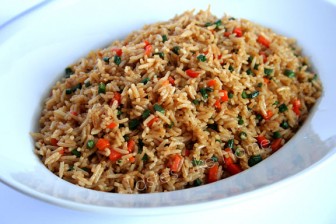Hi Everyone,
A good Fried Rice is a dish that many of us aspire to perfect. Each time we make it, we tweak the recipe or methods of cooking the star of any fried rice – the rice. We want to replicate it to have the taste that the Fried Rice we buy from our favourite Chinese restaurant has. Sometimes we get close but for the most part, we end up creating our own unique Fried Rice that is just as tasty but it is never exactly the same.
Over the years of writing this column, I’ve answered lots of questions relating to Fried Rice. Over the years, I too have asked many questions about Fried Rice. Through the delicious world of food blogging, I have picked up tips and advice from my friends who are learned in making Fried Rice.
This week I share with you my Fried Rice Primer.
Let’s start with the rice.
 Short or long grain white rice works best. It cooks up easily, cools quickly and separates well once it is cooked properly.
Short or long grain white rice works best. It cooks up easily, cools quickly and separates well once it is cooked properly.
Start by washing the rice; in this case, the washing of the rice is not just to remove the dust etc, but rather to take away some of the external starch that can cause the rice to stick together when cooked.
Cook the rice using the absorption method; we also call that steaming the rice. The water to rice ratio (for white rice) should be 1 cup rice to 1 and 1/3 cups water. Or you can simply add the washed rice to your pot and add enough water that it comes up to the first knot on your index finger (that’s the finger after the thumb). At this stage, I like to add salt to taste to my rice. I like my rice to be cooked with the salt rather than to have it added later, I want the rice itself to have taste. Here’s a tip for colouring the rice uniformly – add a few shakes of soy sauce to the water with the rice. I also add a couple of tablespoons of oil to the rice at this stage as it helps to separate the rice easily when cooled.
 As soon as the pot with the rice and water comes to a boil, reduce the heat to low and let it cook covered tightly for 20 – 25 minutes. When the rice is done you can do one of two things, leave it to cool completely in the pot and then separate it – loosen it, or you can do what I do which is to spread the hot rice onto large baking sheets to cool. I toss it a couple of times while cooling to keep it loose.
As soon as the pot with the rice and water comes to a boil, reduce the heat to low and let it cook covered tightly for 20 – 25 minutes. When the rice is done you can do one of two things, leave it to cool completely in the pot and then separate it – loosen it, or you can do what I do which is to spread the hot rice onto large baking sheets to cool. I toss it a couple of times while cooling to keep it loose.
You would have probably heard by now that leftover or day-old rice makes the best Fried Rice, it’s true and mainly because the rice has had a chance to cool completely. I would suggest that if you are planning to make Fried Rice to entertain for let’s say dinner, you can get away with cooking the rice in the morning. If you’re making it for lunch, then cook it late the night before. Of course you can decide to be super-prepared and cook the rice the day before and refrigerate it.
Ingredients
Less is more when making Fried Rice; often we put too so many things into the fried rice. When I am making Fried Rice I use only two vegetables (as long as I have them in the house) – carrots and or bora.
Flavourings
The ingredients used to flavour Fried Rice are key to giving it that taste we all crave. Ginger, garlic, hot pepper, five spice powder, oyster sauce, dark soy sauce, toasted sesame oil and monosodium glutamate (msg/aji) are all flavour aids that are used to make Fried Rice. Some people use all of the above while others use a combination. The truth is, to each his own in creating the flavour but I wanted to ensure that you know what the list of flavour ingredients are.
Five-spice powder is what is also called Chinese Spice; it is a mixture of five spices that are toasted and ground. The standard recipe for Chinese Five Spice Powder is: star anise, cloves, cinnamon, Szechuan peppercorns and fennel seeds. There is another variation that uses cassia (a member of the cinnamon family), star anise, anise seed, ginger and cloves. Be sure to check the package when you purchase your five spice so that you know what’s in the spice mix, as it will influence the taste of your fried rice.
Dark soy sauce – this is the soy sauce that restaurants use to flavour the food when cooking and to give it colour. Dark soy sauce is different from the regular soy sauce; you will have to read the label. Dark soy sauce is thicker and less salty. It is aged longer with molasses or caramel and a bit of cornstarch added.
Toasted Sesame Oil, take one whiff of this oil and you’ll smile and shout or whisper – eureka! This is the flavoured oil that gives many Asian dishes their unique flavour. My advice is to use this oil sparingly, it is potent, and an injudicious use can overpower a dish.
The debate about the use of monosodium glutamate (msg) continues. Some people are allergic to it. If you already use it when cooking then by all means add a little to your fried rice.
Colouring the rice
The colouring of the rice for fried rice is really a personal decision. I do not set out to deliberately colour my fried rice. Whatever colour it gets is derived from my use of the oyster sauce or the drizzle of dark soy that I add for flavour. However, whenever I am entertaining, especially Guyanese, I go out of my way to colour the rice because I know that that is what is expected. To do so, I add light soy sauce to the rice when cooking it. By adding it at this stage, it helps to season the rice and colour the rice uniformly. Light soy sauce is the regular soy sauce and it is more salty than dark soy sauce.
Cooking oil
Use a neutral tasting oil such as vegetable oil or canola oil. However, if you really want to kick things up a notch, use bacon fat to cook the fried rice! Get about 6 – 7 strips of bacon and add it to the cold pan and let it cook until the bacon becomes crisp and all the fat is rendered. Remove the bacon and use the fat/oil to cook your fried rice.
Actual cooking
It is important that you have all the ingredients prepared before you are ready to cook the fried rice. Have all your spices, oils, sauces etc at hand because once that pan is on the stove and the oil heated, there is no time to idle. If possible, have everything lined up in the order in which you are going to use them. The recipe you are using will dictate the order.
The use of green onions (shallots)
Green onions/shallots are great to eat with fried rice. However, the fried rice can go off or have a peculiar smell if you are not careful in how you use this ingredient.
I use the sliced green onions as a garnish to be eaten with the fried rice. Do not sprinkle the green onions on top of the fried rice unless you are serving it to be eaten right away. When you are entertaining, have a bowl with the sliced green onions next to the platter with the fried rice so that people can take as much or as little as they like. Let me repeat, do not finish cooking the fried rice, sprinkle it liberally with green onions and then leave it to be served later, or to be served partially. Add the green onions when you are sitting down to eat the fried rice.
Shopping for ingredients
As a rule, when I am purchasing certain ingredients pertaining to specific cuisines, I always try to purchase them from grocers, markets or supermarkets that specialize in these ingredients. Often you get the more authentic ingredient and the variety that you need.
For the ingredients mentioned in this column – five spice powder, oyster sauce, dark soy sauce, toasted sesame oil – you can find them in the many Chinese stores that are now in Guyana. When I was there last year, I saw these ingredients in various stores.
After all of this talk about fried rice, I think I know what I am cooking tomorrow.
Next week’s column will feature the very famous fried rice which is still the standard by which all other Chinese fried rice dishes are judged: Yangzhou Fried Rice!










